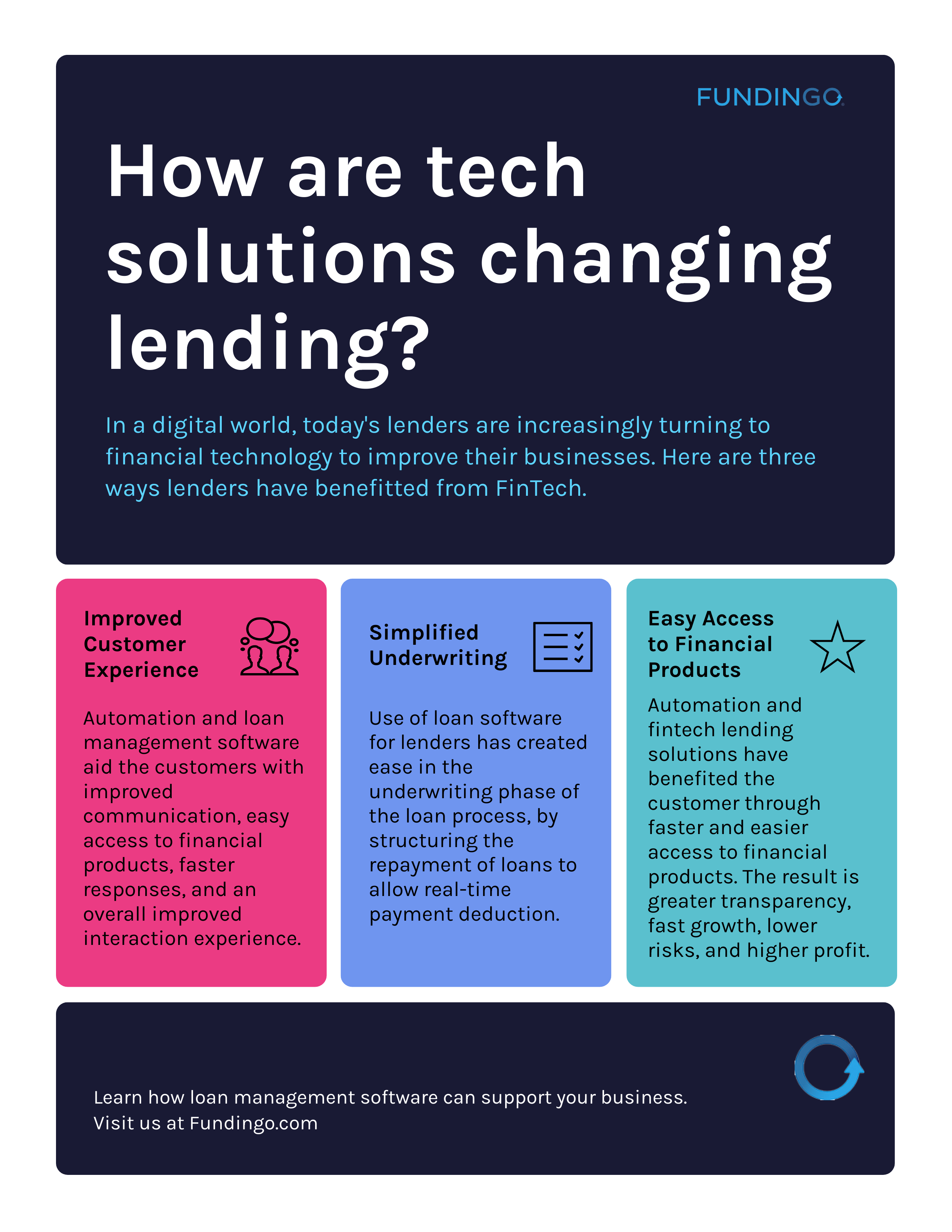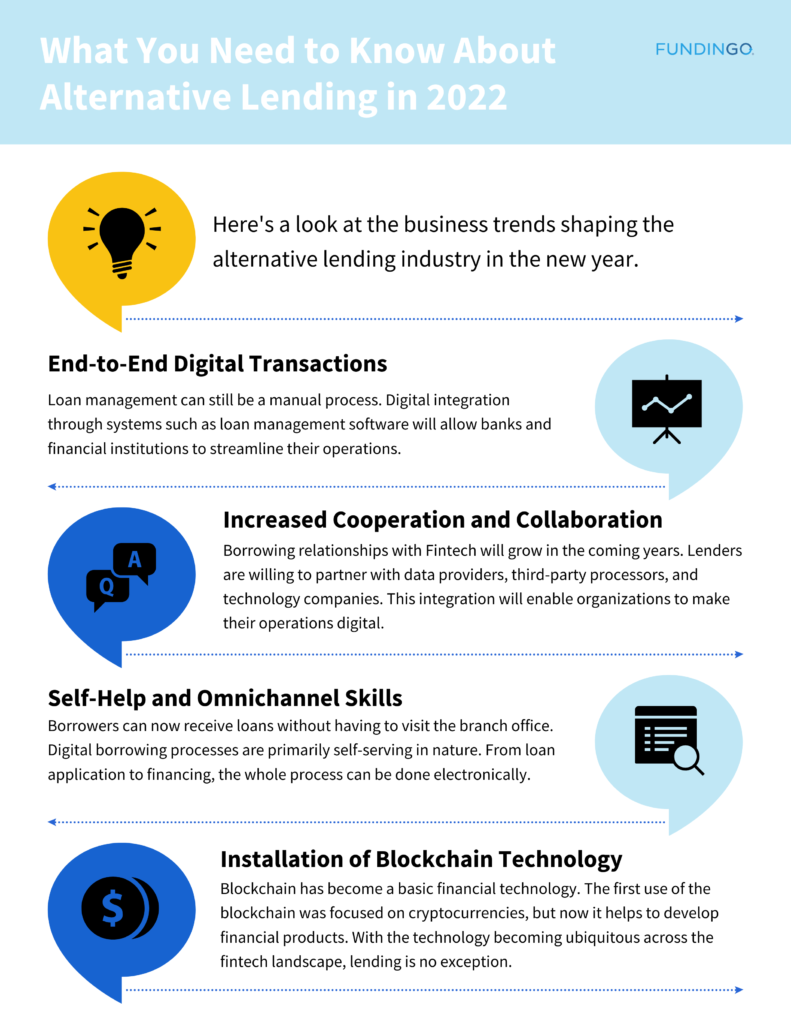
Lending Tips
Have you ever taken a good look at how many individual steps your day-to-day operations involve? How many different documents or spreadsheets do you handle a day? How many programs do you use to manage them?
With the right apps and integrations, you can handle more than just loan management in Salesforce. Lenders can manage ACH transactions, background and credit checks, and documentation within the platform. The result? A clearer picture of your business.
Getting Started
First, what’s the difference between a Salesforce App and a Salesforce Integration? Apps are built natively in Salesforce and downloaded directly from the AppExchange. Integrations are separate programs that communicate information with Salesforce. Both let you choose how you want Salesforce to work, but you have to download integrations from their respective sites.
What they have in common is that they both give you more ways to manage your cloud lending. If you want more data, you can collect it with an app. If you want to assess risk, you can add an integration. However, there are three types of features that all lenders need. Once you’ve covered the necessities, you can add features to boost your competitive advantage.
ACH Processing
Your digital lending would be all but useless without ACH processing. Think just for a moment about all the transactions you handle from day to day. To make your transactions move quicker, you can move them to Salesforce.
In addition to providing faster transactions, bringing ACH processing to Salesforce creates fewer processes. Integrating these services makes it simpler and safer to process funds. You can choose from Salesforce integrations built for ease-of-use, your transaction volume, or any number of factors. Here are two examples of ACH processor Salesforce integrations.
ACHWorks is an ACH processor with Salesforce integration that’s been around since 1993. Its set-it-and-forget-it style means that once you configure it, it runs on its own. But what about security? Worry not. They prioritize, keeping sensitive information safe. ACHWorks includes encrypted transactions, tokenized account information, and hands-on support.
If you want a highly customizable ACH processor, it’s ACH.com. Their service handles recurring transactions, system-generated file uploads, and one-time web transactions. They also offer real-time analytics for more complete data. To top it off, ACH.com will handle your setup, training, and maintenance.
Risk Assessment
Assessing risk is one of the most important tasks you have as a lender. Think of how many different programs you use to get the complete picture of your borrowers—background checks, credit checks, spreadsheets, or databases managing their information. The list goes on. What can you add to reduce your risk assessment to a series of clicks?
First, move all the data about your deals to Salesforce, so you’re working with the complete picture. Next, integrate programs to verify, check, and assign risk scores to that data. Need some ideas to start? Here are some Salesforce Apps and Integrations to get you started.
One of the most well-known platforms for risk checking, Experian offers full Salesforce integration. You can verify phone numbers, email addresses, and postal addresses all from inside Salesforce. They’re also Salesforce Service Cloud Certified, so you know you’re banking on quality. Their data verification service works in over 240 countries and includes live support for around the clock help.
LexisNexis comes as a Salesforce App, available right from their AppExchange. They specialize in gathering data on your applicants, populating it in Salesforce, and using the data to evaluate your borrowers’ risk. LexisNexis also provides you with a score generated using all risk data, including non-traditional credit data. Coupled with Experian’s data verification service and your processes in Salesforce, risk evaluation can move faster and do more.
If you work with construction loans, you know the importance of having regular site inspections. Keeping them scheduled tightly with milestones can be managed right from Salesforce. When a site is ready to be inspected, you can make everything happen with the click of a button.
Quiktrak doesn’t just order your site inspections. It checks data to confirm you have the right site, adds detailed reports to your opportunity or deal, and leaves them readily accessible whenever you need them. Need multiple inspections? Don’t worry. You can order as many as you need without leaving Salesforce. QuikTrak also keeps track of interviews, photos, notes, and summaries. Since it’s an app, you can quickly download it from inside Salesforce.
Document Management
Lending is document-heavy. You don’t have to look around at the files and loose papers to know. Contracts, releases, agreements, notes. When lenders talk about streamlining their digital lending, they’re talking about this. How do you get your documents integrated without wasting more time? And what more do you stand to gain?
Uploading paper documents is only part of the process. Making sure you have the information available and being able to use it are arguably even more critical. Ocrolus takes scanned documents and organizes them based on their contents. Tax forms stay with tax forms. Bank info stays with bank info. And all of them stick with their deals. Additionally, their scanner checks for tampered documents and provides you with fraud alerts when detected.
Document management is only one part of the process. Have you considered document generation? Conga allows you to create on-brand documents for your clients, which you can send for digital or in-person signatures. Its interface is easy to navigate and intuitive, taking pressure off your sales team. You can also pick templates and merge documents.
Final Thoughts
Your CRM is only worth it if you use it. While these are only a selection of Salesforce’s functionalities for lenders, you can configure it to do nearly anything you need. Covering your basics is just the starting point. After, you can start handling your client communications, marketing, and even support in Salesforce.
When your loan management takes place in Salesforce, the rest is up to you. If you’re unsure about which services can help mold your CRM to your lending, reach out to a certified Salesforce administrator who can help you choose.

Lending Tips
You organized your deals in your lending platform. You set up your processes. Everything is running smoothly and you have an invaluable resource at your fingertips. Data. The question is, how can you put it to work?
If you think about it, everything we do creates some form of data. Every website we visit, app we open, or email we send shows something about us. It isn’t just big businesses that are using data these days. Even small companies have found ways to improve their processes using data.
So how can you leverage data? Do you need to bring in a third party to interpret it or can you go at it alone? How do you get started using your data?
If you feel overwhelmed, don’t stress. Data is your friend, and it can lend powerful insights into your lending’s potential. To make it easier, we’ve listed five steps to help you get started collecting and applying your data.
1. Choose the right software
The key to pulling insights from your data is the right software. Your lending creates a monumental amount of data, and without the right tools, you will miss out on the information you need to make smarter decisions. No human can process all of this data alone. This is where machine learning comes in.
Much like “big data,” machine learning is another term that many use and few understand. What machine learning is is a form of artificial intelligence. It serves to processes and learn from this raw data so it can perform a task.
In this case, make sure you know what you need when you look for your data processing and analytics software. It’s good to have an understanding of where you’ll be drawing your data from. You could start with your CRM or fintech lending platform, for example. Then, look for software compatible with the tools you already use. How can you evaluate the software? That leads us to the next tip.
2. Ask the right questions
Without knowing what questions you’re asking from your data, you will not get your answers. Always make sure that you have your goals in mind so you can understand what kind of data and software you need.
For example, are you looking to reduce the time you’re spending assessing risk? How much time is it currently taking? What are the steps, and how many people does it take? These kinds of questions will make you think about what the “right” integration is for you.
3. Plan broader goals
When you know what you’re looking for, you can start to use your data to get you farther than you may have imagined. Plan distinct, actionable goals for where you want your lending to be. Do you want to take on more deals? Then your data can show you what is currently stopping you and how to improve. Do you want fewer errors? Your data can show where they’re most often made (and even take a stab at why).
While it may be tempting to choose small goals, your competition is aiming higher. Plan for tomorrow, not for today. Successful lenders pay close attention to their industry and forecasts. This is how they know where to target their efforts and measure them with data.
4. Measure progress with your data
Once you’ve got your goals planned out and your software set up, it’s time to measure your progress. Let’s imagine that you’re trying to cut time spent processing transactions. Are the numbers lower now than they were to start? If not, take a deeper look and see what part of the problem remains. It’s not a matter of if you can achieve what you’ve planned; it’s a matter of how.
Modern loan management software offers features that make data digestible. These include visual dashboards, custom reports, and custom notifications. Use them to your advantage. If the numbers look off or if you don’t see what you need, reach out to their support center. They can give valuable tips you can tailor the software to your business.
5. Automate your processes
Once you’ve got the hang of your software, you can apply what you’ve learned to other parts of your business. Track the health of your deals with common indicators from past transactions. Standardize your processes by ensuring that all your staff uses the same flow. Better yet, set up automatic prompts to ensure that no deal is missing information.
Keep in mind that your goldmine of data isn’t limited to your actual loans. You can apply the same method anywhere in your business. Remember, work smarter, not harder.
Conclusion
Don’t let the buzzwords catch you off guard. You and your team can learn and apply big data, machine learning, and analytics to help even the smallest of businesses. With the right software, questions, and support, you can automate your way to success.

Lending Tips
How Tech Solutions are Changing Lending
If you work in lending, you may have noticed that technology is changing the landscape of how we operate. Perhaps you’ve encountered buzzwords such as ‘Automation’, ‘FinTech’, and ‘SaaS’. These terms represent more than just trends- they exemplify some of the innovation that is driving our industry forward, and it is crucial to understand how to harness that potential.
Financial Technology, better known as FinTech, initially referred to back-end systems technology, but has now evolved to describe consumer-oriented services such as those included in the lending process. Fintech facilitates entrepreneurs and businesses in managing their financial operations with ease, facilitates automation of the financial services, and aims to improve the user experience.
FinTech has eased the lending process largely through the automation of core functions in the life cycles of loans. Loan origination software enables end-to-end automation and management of the entire lending process. Each phase of the loan process, namely: pre-qualification, submission of application, application processing, underwriting, approval of application, documentation, credit check, and loan funding are automated and managed through a loan management software.
Why is lending turning to technology?
Today’s customers are tech savvy, and businesses need to be even savvier. Clients expect easy access to applications and speedy turnarounds. In order to keep up and save time, companies are increasingly turning to automation. When it comes to qualification, leveraging third-party data sources allow lenders to assess potential customers and ensure eligibility. These sources provide huge volumes of data that need to be efficiently processed to align the relevant information, which is easily done through using a loan management software. The result is less time wasted on manual processes for lenders and faster loan servicing for the customer.
What are the Benefits of Automation and Loan Management Software?
Improved Customer Experience
In the past the 4P approach of marketing focused solely on the Product, Price, Place, and Promotion of a good or service. However, with time businesses evolved to a more customer-oriented strategy that is both rewarding and builds long-lasting customer relationships. This approach focuses on enhanced communication and customer-friendly solutions. Automation and loan management software aid the customers with improved communication, easy access to financial products, faster responses, and an overall improved interaction experience.
Additionally, automation and loan management software allow direct disbursement of funds into customers’ bank accounts, require considerably less documentation, and ensure seamless delivery. Lending companies are investing in dedicated customer care teams and reaping the rewards in the form of increased return on investment. Automation has served both the companies and the customers by easing the whole lending process; more options in the market have led to increased competition and better choices.
At Fundingo too, we strive to provide instant and accurate insights at each phase of the lending process with our loan origination software. Apart from offering a seamless lending process, we believe in maintaining a loyal customer base. Customers can enjoy a smooth and streamlined loan service experience from a single, efficient platform.
Simplified Underwriting
Use of loan software for lenders has created ease in the underwriting phase of the loan process, by structuring the repayment of loans to allow real-time payment deduction. Customers do not require mortgages for underwriting their application either. At Fundingo, we have fundamentally restructured loan servicing by transforming hours of loan servicing time to merely a matter of minutes.
Easy Access to Financial Products
Automation and fintech lending solutions have benefited the customer through faster and easier access to financial products. Due to this easy access, previously neglected businesses and customers have benefitted from cost-effective and fast credit options too. Apart from this, loan management software platforms such as Fundingo offer complete transparency from the origination stage through underwriting to renewals and loan services. This enables fast growth, low risks, and significantly higher profits.
Final Verdict – The Significant Importance of Automation and Loan Software for Lenders
Tech Solutions have revolutionized the lending process, and for the better. Customer-centric approach is the need of the hour, and time is of the essence. By acknowledging the concerns of customers and providing quick and easy access to financial products and services, automated lending has come here to stay. If you want to leverage automation and tech solutions for optimizing your business, contact Fundingo for their loan management software offering complete transparency and the opportunity to benefit from high profits with low risks.


Lending Tips

Are you choosing the right loan servicing software?
Choosing the right software for corporate support can be an overwhelming task, particularly when it is related to your core service. It is essential to understand the requirements of your business and only then proceed in a programmed manner to make the right choice. While it wouldn’t be far-fetched to call this a make-or-break decision for your business, we’ve made it easier for you by providing a framework for the right protocol.
From years of firsthand experience, we have summarized the essential practices required for choosing the right loan servicing and/or cloud lending software into 4 essential steps. With these steps, you will be able to choose software with long-lasting benefits for your business.
- Assessing Your Needs
- Exploring Your Options
- Evaluating the Shortlisted Options
- Implementing Your Final Choice
Assessing Your Needs
Before you start exploring options for lending software, it’s best to consider some crucial internal factors of your business such as the short-term and long-term requirements and goals of your business, the requirements of your customers, the method of delivery for your software, etc.
Business Needs
Start the process of choosing the right cloud lending software by analyzing your business goals, requirements, and strategy. The lending software is meant to aid your business strategy so it should be aligned with your business goals. For this, you’ll need to sit down with your team and create a needs-gap analysis by going through some key questions, such as:
- Where is your business standing today and where do you see it in the long term?
- Is your current software system up to par? If not, then where is it lacking?
- What additional functionalities could improve your current cloud lending software?
- Could another cloud lending software provide improved credit scoring and enhanced automation?
- Who would be using this software?
- Would you opt for in-house lending software or off-site cloud lending software? Also, would you have a dedicated IT team for managing the in-house software system?
User Needs
For any business to succeed, it’s essential to know its users and their needs, so whatever you do keep your users the center of your focus. Sit down with your entire team, from the top management to the loan lending officers who will be dealing with the customers first-hand. Conduct surveys among your users to find out just how successful your potential software system will be practical.
Software Hosting Method
Another key factor that will impact your business is choosing the method of delivery for your loan lending software. There are two main methods to choose from:
- The first is the conventional method of purchasing a software license for an in-house software program. The license covers all the IT support staff that will be managing it. This in-house software and its database are physically loaded onto servers and your corporate computer systems, thereby allowing a user to use the system.
- The second method is called Software as a Service (SaaS), and it refers to an off-site, secure cloud lending software operated through a third-party organization. This option suits small to medium businesses, as you don’t have to arrange a dedicated IT team for it. The software is managed by the cloud lending software organization for a monthly fee.
Exploring Your Options
Once you’ve determined the internal requirements of your business, it’s best to explore what software options are available. Focus on key areas such as service functionality, flexible management, smart automation, and credit scoring. Once done, shortlist options that are excelling in these areas.
Software Functionality
An ideal cloud lending software partner has a flexible integrated origination and servicing platform. It offers individual modules, letting you choose what you need currently while always having the option to access more features if and when needed in the future. The loan origination features should include:
- Automated calculation of loan amount, term period of the loan, and the interest rate, etc.
- Automated decision-making
- Flexible management of the lender’s credit policies
- Remote access for different sales points
- Separate evaluation processes for different business products and business production line
- Swift adjustment to new lending rules and policies
- Customized tracking
Smart Automation
As a business person, your goal is to opt for a software system that streamlines your process and allows you to increase revenues. Therefore, you should look for software that will automate several tedious tasks allowing your team to focus their energy on important decisions and tasks. The software must be flexible for managers to use according to their style, and it should be easy to integrate with multiple vendors.
Optimal Credit Scoring
Only a lending software that aids in risk management for both new and current accounts alike, will get you optimal credit scoring. The best program choices offer integration with all the credit reporting agencies. The best programs also make use of machine learning and data analysis. By incorporating artificial intelligence, these programs continuously update and improve their credit scoring capabilities, so it’s best to look for software choices that check the boxes for these traits.
Evaluating the Shortlisted Options
Once you’ve successfully found some great options on your hunt for the right cloud lending software, you may evaluate them further to get your business the right and worthy solution. You can start the evaluation process by getting to know your shortlisted finalists a bit better.
Create a carefully thought-out spreadsheet of important questions regarding their modules, customization scope, pricing, security, etc. Meet with their sales reps and ask them these questions. You may even request an online demonstration of their software. Note down any further questions that may arise during these demos and make sure to get your answers before making your final decision. You can even conduct surveys with their current clients to get a better picture. It’s better to be sure of what you’re signing up for, than suffering from business loss down the lane due to a hasty choice.
Affordability
Price is an important factor while choosing the right loan servicing software for your business, as you wouldn’t want to upset your resource allocation plans. Therefore, it’s best to opt for a provider offering only those functionalities that you require instead of paying for features you wouldn’t be utilizing. We would recommend choosing a software partner that allows you to access the functionalities you need and upgrade as your needs evolve. Keep all necessary, potential costs in check before making a decision. These costs include software and hardware costs, implementation costs, training costs, data conversion costs, etc.
Previous Performance History
Do not merely rely on the advertised credentials of a service provider, instead ask for demos and conduct surveys. Ensure that your potential servicing software provider has a proven performance history. You must ensure that lending is their core function, and not just a side hustle. Check for press publications regarding their performance. Also, see how long they have been in business. You can also check online for reviews of actual users and see if the provider has expanded over time and/or bagged any awards for their previous performance.
User-Friendly Installation and Operations
The right software is also easy to understand and implement. There is no benefit in saving on resources by opting for a cheaper option that isn’t easy to use, as all the ‘saved’ resources will have to be redirected on training your staff to understand it, and there still might be lots of errors and time and opportunities will be lost.
Therefore, choose software that can be readily and easily installed. This is another reason why we are slightly partial to cloud lending software. Secondly, your employees should be able to easily use it. It shouldn’t have manuals and instructions filled with lots of technical jargon.
24/7 Customer Service
When you’re an entrepreneur, you do not want to risk missing out on any opportunities due to technical failures or any reason whatsoever. That is why you must opt for lending software that offers 24/7 customer support to your employees. Also, the customer support staff must be experts in providing solutions to resolve issues in the first contact.
Implementing Your Final Choice
Now that you have done a thorough assessment of your requirements and the available options, and you have also weighed the pros and cons of those options, you must not sit on the fence. Make that call now, because you know exactly which vendor seems to offer and excel in the expertise that your business requires. Carefully develop an internal proposal that will guarantee you secure buy-in from all your stakeholders, before you announce your decision outward. Make sure to communicate all your requirements and how they match with your chosen vendor’s expertise.
Final Words
Although these steps may seem time-consuming at first, proceeding forth with this carefully structured decision-making framework is bound to benefit you. It should help you choose the right cloud lending software and help your business get on track for the best opportunities. After all, at Fundingo our main goal is to save you from the loss of time, effort, business opportunities and money that can result from using the wrong servicing software.

Lending Tips

Image courtesy of Vecteezy.com
WHAT IS ALTERNATIVE LENDING?
With an increase of small business owners across the U.S., organizations have often experienced difficulties when it comes to making money. Fortunately, the Alternative Lending industry has developed as a solution.
Alternative Lending describes loan options available to consumers and business owners besides a bank loan. These alternative methods are often used where a person or business owner is unable to obtain a bank loan for any reason. Some lenders specialize in using less secure securities such as real estate or residual invoices to protect loans. They are generally more flexible than banks when it comes to payment systems and loan approvals and often offer cash much faster than their traditional banking counterparts. The Alternative Lending industry is well established and often has well-respected employees of the financial services community.
EVOLUTION OF ALTERNATIVE LENDING
The first major lenders in the United States, Prosper and Lending Club, arrived on the scene in the mid-2000s providing personalized peer-to-peer lending. This introduced a new lending system that has grown into a business venture. Historically, banks have viewed small businesses as financial risks, preferring to finance larger enterprises.
For new business owners who need help getting started and who do not yet have a proven sales record, it can be very difficult to qualify for a bank loan. One usually needs not only excellent personal and business credit, but also proof of income, financial efficiency, and at least a few years of experience in running the business. And in many cases, banks prefer to lend in large sums, which small businesses rarely need.
After the economic downturn in 2008, financing for small businesses declined sharply, leaving room for some lenders to close the gap. According to the Wall Street Journal, interest rates have dropped by 38% over an eight-year period; The top 10 banks offered joint venture loans of $ 72.5 billion in 2006, but $ 44.7 billion in 2014. Some lending companies began lending businesses to help small businesses avoid bankruptcy.
HOW IS ALTERNATIVE LENDING DIFFERENT FROM TRADITIONAL LENDING?
Some loans are usually faster, more affordable than regular loans. Unlike banks, which usually require you to submit a detailed business plan and dozens of financial documents, all of which can take months to consolidate, different lenders usually only need your credit notes and the latest tax returns and bank statements.
Thanks to advanced micro-contractor systems that incorporate advanced human technologies, various online lenders can speed up the writing process and postpone a decision very quickly. As a result, lenders can issue answers within days, or sometimes even hours.
Applying for a bank loan, on the other hand, is often a long and difficult process. The average waiting period is three months for a response. And once you have heard, you may need to arrange your meeting in person and provide copies of your financial statements as part of the accreditation process. These extra steps can take a lot of time and effort to run your business.
Other loans are also more flexible in terms of borrowing and pricing. Although banks generally do not consider it financially advisable to borrow less than $ 250,000, some lenders offer loans of up to $ 5,000.
WHAT TO LOOK OUT FOR IN ALTERNATIVE LENDING IN 2022
Lending trends for 2020-21 involve lenders’ focus on comparing consumer expectations, using the omnichannel, and improving lending efficiency. Now, let’s look at lending business trends that will shape the industry by 2022.
End-to-End Digital Transaction
The most important trend in lending will be to increase digital productivity. Loan management can still be a manual process. Since accuracy is important in this business, a lot of manual labor goes into document verification. All the steps – from applying for a loan to the issuance and collection, including manual labor. Lending businesses that still rely on these legacy systems will need more pressure to perform their digital operations. For customers, doing digital will bring ease. Digital integration through systems such as loan management software will allow banks and financial institutions to streamline their operations.
Increased Cooperation and Collaboration
Borrowing relationships with Fintech will grow in the coming years. Lenders are willing to partner with data providers, third-party processors, and technology companies. This integration will enable organizations to make their operations digital.
Self-Help and Omnichannel Skills
Borrowers can now receive loans without having to visit the branch office. Digital borrowing processes are primarily self-serving in nature. From loan application to financing, the whole process does not require manual intervention. Customers will not be required to contact creditors unless required. These machines also free workers from work.
Installation of Blockchain Technology
Blockchain has become a basic financial technology. The first use of the blockchain was focused on cryptocurrencies, but now it helps to develop financial products. Simply put, it is a shared, encrypted website – a distributed ladder. It makes the banking process faster and less bureaucratic.
Although banks have grown more sensitive to lending to small and medium enterprises – largely due to increased regulatory responsibilities – businesses in the central market are still able to access credit opportunities through these financial institutions. With a simple borrowing process and easy access to key capital, lenders are a very attractive option, which introduces the potential for potential growth and profitability in the future.
PROS AND CONS OF ALTERNATIVE LENDING:
Alternative forms of Lending were designed to give small businesses easy access to finance, as well as additional opportunities for growth, job creation, and profitability. With the help of alternative lending, one can upload all information with just a few clicks at a convenient time without wasting time preparing paperwork, writing a business plan, or attending a bank meeting during normal business hours. Clients can have twice the chance of being approved by another lender. Whether you need to make a down payment on a new office building, replace damaged equipment, or repurchase a best-selling stock, various lenders work quickly to get your money back, sometimes bringing you money in just a few hours. With some lenders, you can choose from a few of the financing options to find the one that works best for you. Whether you want $ 5,000 to upgrade to a savings office, need to use the remaining invoices as collateral to protect your mortgage, or need $ 30,000 to renovate buildings, other lenders can help.
Problems with Alternative Lending are few, but important to note. Here are two factors to consider: Banks do not accept almost as many applicants as other lenders, so they may charge lower interest rates. Consider: APR 3-6% of traditional bank loans compared to 10-30% of APR for non-bank lenders, depending on the type of loan and the company. If you do not budget carefully with another lender, you may end up spending interest instead of thinking about how you can improve your profits. However, not all unique lenders will pay off debts, and many offer a non-binding application to assess what you qualify for without charge. Some lenders usually have shorter borrowing terms than banks – about one to five years. Borrowing existing businesses is a risky investment, but the short term is also because different lenders tend to borrow less than banks. With less money to pay off your debts, you may have major monthly payments, which may mean that you may be forced to suspend certain business plans or end up running out of money.









